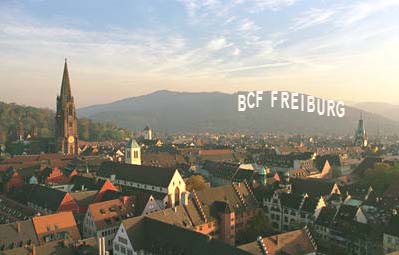Jürgen Hennig (Medical Physics, Department of Radiology, University Hospital Freiburg)
"Investigation of Spatiotemporal Brain Dynamics with MR-Encephalography (MREG)" / Wednesday, May 18, 2011, 17:15
|
The Bernstein Center Freiburg
& BrainLinks - BrainTools Initiative Bernstein Seminar
|
 |
|
Jürgen Hennig
Medical Physics
Department of Radiology University Hospital Freiburg Investigation of Spatiotemporal Brain Dynamics with MR-Encephalography (MREG)
|
|
|
Wednesday, May 18, 2011 17:15 h |
Lecture Hall (ground floor) Bernstein Center Freiburg Hansastraße 9A 79104 Freiburg |
|
Abstract:
Functional magnetic resonance imaging (fMRI) is established as a robust tool for mapping of the spatial location and distribution of cortical areas involved in the processing of a given task. More recently fMRI has also been used to map cortical networks active at rest or in specific brain states like sleep. fMRI-measurements are based on the hemodynamic response elicited by neuronal activation, activation maps are inherently static. Measurements of functional connectivity are therefore based on indirect methods i.e. the intermodulation of activation pattern. Our recently developed method of MR-encephalography allows to monitor brain activitiy at unprecedented speed. In a current implementation MREG allows full-brain mapping (64x64x64 voxels, 4 mm isotropic resolution) at 10 fps and more. For functional mapping this allows to remove the dominant physiological signal variations (ECG and respiration) which leads to a considerable improvement of sensitivity compared to standard fMRI. Furthermore dynamic studies can be performed. The primary source of the signal still is related to the hemodynamic response, therefore the observed spatiotemporal variations are filtered by the regionally and individually variable hemodynamic response function (HRF). Using incremental stimulus designs and correlation with EEG, MREG allows to infer the spatiotemporal patterns of neuronal activity. Experiments so far have shown spatiotemporal evolution in different paradigms using visual stimulation as well as the observation of resting state networks in a frequency window beyond 1.5 Hz. |
|
|
Host: Ad Aertsen
|
|
|
The talk is open to the public. Guests are cordially invited!
www.bcf.uni-freiburg.de |
|
abgelegt unter:
Bernstein Seminar

